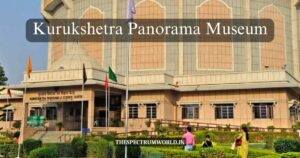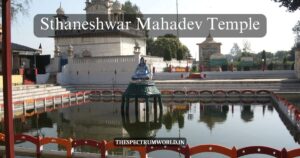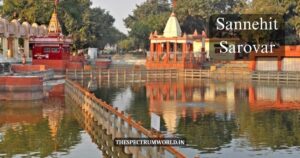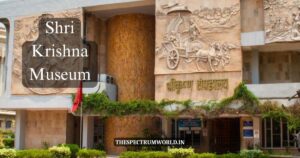Kurukshetra: 15 Best Places to Visit
Kurukshetra, a small town in the state of Haryana, India, is a treasure trove of history, mythology, and culture. This ancient city, nestled in the Indo-Gangetic Plain, is steeped in significance, being the site of the epic Mahabharata’s Kurukshetra War. As you embark on a journey to explore Kurukshetra, we delve into its rich heritage, unraveling the mysteries of this revered destination.
Table of Contents

Historical Significance
Kurukshetra’s history dates back to the Vedic era, around 1500 BCE. The city’s name, derived from King Kuru, a legendary ruler, signifies its importance in Hindu mythology. The Kurukshetra War, a pivotal event in the Mahabharata, is believed to have taken place here, making it a sacred site for Hindus.
Historical Background of Kurukshetra
It is a city in the state of Haryana, India, has a rich and diverse historical background that spans over 4,000 years. The city’s history can be broadly divided into several periods:
- Vedic Period (1500 BCE – 500 BCE): It was an important center of Vedic culture and learning. The city was mentioned in the Rigveda, one of the oldest Hindu scriptures.
- Mahabharata Period (500 BCE – 300 BCE): According to Hindu mythology, it was the site of the epic Mahabharata’s Kurukshetra War. The city was the capital of the Kuru Kingdom, ruled by King Dhritarashtra.
- Mauryan Period (300 BCE – 200 BCE): It was part of the Mauryan Empire, ruled by Chandragupta Maurya and his successors.
- Gupta Period (200 CE – 550 CE): During the Gupta period, the city experienced a resurgence in culture, art, and architecture.
- Medieval Period (550 CE – 1500 CE): It was ruled by various dynasties, including the Tomars, the Chauhans, and the Mughals.
- Mughal Period (1500 CE – 1800 CE): Kurukshetra was an important center of trade and commerce during the Mughal era.
- British Period (1800 CE – 1947 CE): It was part of the British Empire, and the city experienced significant modernization and development.
- Post-Independence (1947 CE – present): After India gained independence, the city continued to grow and develop, becoming an important center of education, culture, and tourism.
Archaeological Significance
It has been the site of several archaeological excavations, revealing a rich cultural and historical heritage. Some notable discoveries include:
- The discovery of the ancient city, dating back to the Mahabharata period.
- The excavation of the Kurukshetra Panorama Museum, showcasing the city’s history and culture.
- The discovery of several ancient temples, including the Sthaneshwar Mahadev Temple and the Bhishma Kund.
Kurukshetra’s historical background is a testament to its enduring significance as a center of culture, learning, and spirituality.

Places to Visit in Kurukshetra
It is a treasure trove of historical, cultural, and spiritual significance. The city boasts an array of architectural wonders, showcasing its cultural and historical richness.
- Kurukshetra Panorama Museum: A stunning display of the Kurukshetra War, depicted through intricate paintings and sculptures.
- Bhishma Kund: A sacred tank, believed to be the spot where Bhishma, a revered warrior, lay on a bed of arrows.
- Jyotisar: A revered site, marking the spot where Lord Krishna delivered the Bhagavad Gita to Arjuna.
- Sthaneshwar Mahadev Temple: An ancient Shiva temple, dating back to the Mahabharata era.
- Kurukshetra University Museum: A museum showcasing the city’s history, art, and culture.
- Birla Mandir: A beautiful temple dedicated to Lord Krishna and Radha.
- Shri Krishna Museum: A museum showcasing the life and teachings of Lord Krishna.
- Kurukshetra War Memorial: A memorial dedicated to the heroes of the War.
- Raja Harsha’s Fort: A historic fort, dating back to the 7th century CE.
- Sheikh Chilli’s Tomb: A 16th-century tomb, built in memory of the Sufi saint, Sheikh Chilli.
- Kurukshetra Lake: A scenic lake, offering boating and picnic facilities.
- Pandava Theertham: A sacred site, believed to be the spot where the Pandavas took a dip before the Kurukshetra War.
- Sannehit Sarovar: A sacred tank, believed to be the spot where the Pandavas performed their rituals.
- Amin Kund: A sacred tank, believed to be the spot where the Pandavas took a dip.
- Guru Jambheshwar Temple: A temple dedicated to Guru Jambheshwar, a revered saint.
These places offer a glimpse into its rich history, culture, and spirituality, making it a must-visit destination for anyone interested in exploring India’s heritage.

Unique Facts About Kurukshetra
- Birthplace of the Bhagavad Gita: It is the site where Lord Krishna delivered the Bhagavad Gita to Arjuna, making it a sacred destination for Hindus.
- Ancient Vedic Center: It was an important center of Vedic learning and culture, dating back to the 1500 BCE.
- Site of the Mahabharata War: It is believed to be the site of the epic Mahabharata’s War, fought between the Pandavas and the Kauravas.
- Home to the Kurukshetra University: It is home to the Kurukshetra University, one of India’s premier educational institutions.
- Sacred Tanks and Lakes: It has several sacred tanks and lakes, including the Bhishma Kund, Sannihit Sarovar, and Pandava Theertham.
- Ancient Temples: It is home to several ancient temples, including the Sthaneshwar Mahadev Temple, dating back to the Mahabharata era.
- Gita Jayanti Celebrations: It hosts the annual Gita Jayanti celebrations, commemorating the birth of the Bhagavad Gita.
- Kurukshetra Festival: The city hosts the annual Festival, celebrating its rich cultural heritage.
- Historical Significance: It has been mentioned in several historical texts, including the Rigveda, the Mahabharata, and the Puranas.
- Archaeological Site: It is an important archaeological site, with several excavations revealing its rich cultural heritage.
- Spiritual Significance: It is a sacred destination for Hindus, Jains, and Sikhs, attracting millions of pilgrims annually.
These unique facts highlight Kurukshetra’s significance as a cultural, historical, and spiritual destination, making it a must-visit place for anyone interested in exploring India’s heritage.

Cultural Heritage
Its cultural landscape is a vibrant tapestry of traditions, festivals, and customs. The city comes alive during the annual Kurukshetra Festival, celebrating its rich heritage through music, dance, and art. The local cuisine, a delectable blend of Haryanvi and Punjabi flavors, is a must-experience.
Spiritual Significance
It is a sacred destination, attracting pilgrims and seekers from across the globe. The city’s spiritual energy is palpable, with numerous temples, kunds, and ashrams dotting the landscape. Visitors can immerse themselves in the city’s spiritual ambiance, seeking enlightenment and solace.
Conclusion
It is a city steeped in history, mythology, and culture, offers an unparalleled experience for explorers and seekers. As we unravel the secrets of this ancient city, we are reminded of the significance of preserving our cultural heritage. Whether you are a history buff, a spiritual seeker, or simply a curious traveler, Kurukshetra beckons you to explore its timeless wonders.
Read and explore more: Ludhiana: 15 Best Places to Visit







One thought on “Kurukshetra: 15 Best Places to Visit”